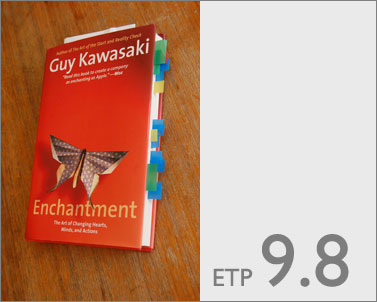I just finished reading “Enchantment: The Art of Changing Hearts, Minds, and Actions” by Guy Kawasaki. It joins my collection of Could-Not-Put-It-Down books. It was overall a fluid and well-structured treatise filled with practical suggestions and insightful observations on behaviors that trigger responses of inner attraction and appeal. (Underlines are my way of “sucking up.” Read the book and you’ll get the idea!)
[I will digress for a moment to put enchantment in terms of the ion attraction models that I am familiar with. If two bodies are at infinite distance apart, there is theoretically zero attraction. At any real distance however there is some level of attraction (think exponential decay, approaching but never reaching zero). As the bodies get closer, there is an increase in attraction. At some point, the bodies are close enough to be involved in some weak holding pattern (the outer layer of influence -> speaking in 2d but we could just as readily say outer sphere for a 3d model). Closer still, the bodies interact and actually form a strong bond (high energy) and deviation becomes limited (an inner layer that is somewhat structured and ordered). If the resulting proximity of the bodies can result in a reaction, then the two bodies might transform into a new entity (hopefully stable) OR if there is a propensity for it, a smaller body might bind in the inner channels of the larger body.]
So how did that relate to the book at hand? Enchantment discusses a phenomenon like the inner layer bonding. Enchantment happens at a point at which reactions are likely to occur and there is a level of fixation. But the bodies need to get close enough, through the outer layer – and in a realistic scenario there will be many competing bodies that will serve to thwart bodies reaching the inner layer level (unless sheer Brownian motion or physical momentum causes an actual or near collision).
Time to list my favorite parts of the book:
(1) I found Chapter 2 How to Achieve Likability – Make Crow’s-Feet a great way to show that Enchantment is a genuine and honest pursuit. You can think about your own likability as shown by your muscle behavior, or detecting other’s likability. Likability may be difficult for some to pervade or one may have a phobia about putting forth a likable personality. However, understanding that Likability is an early step to achieving a connection will help our students find an opportunity to even “step into the ring” to start their journey of innovation and leadership.
(2) Chapter 5’s discussion about the “First Follower” is worth presenting to our students.Working in teams in a school (where social structures generally guarantee the availability of first followers), it would be useful to begin the presentation of a new product or idea by having a first follower become engaged in plain sight of potential additional followers. [Quick digression: I guess this has started to get me to think about Flash Mob Dancing – what an exhilarating phenomenon!]
(3) In Chapter 8 How to Use Push Technology, I like the section on Email. Perhaps I will try it by composing an email to Guy Kawasaki, and see if this works for me (I realize mileage may vary). In particular, I like the advice to “Keep it to six sentences.” This is highly consistent with how I have created assignments in my teaching career. When I design an assignment or question, I am looking for an initial response showing that the student is revealing thoughts in an appropriate direction. I would prefer to leave it to the student to determine the depth to which they would go to be satisfied, and develop their answer in a short form just to convince me that that is where they are headed.
I would close by noting that there are many useful tips in this book that could potentially fit into the YCISL content and benefit the participants. These tips could help inspire us to create some great modules. However, the book does seem to weigh closer to adults so some refining or contextual adjustment may be necessary but when it comes to life lessons, there is great value that Guy Kawasaki has shared.
I am also quite excited to start a new analysis based on the fact that for the books I am reading in printed format, I am attaching PostIt tags when I find something that I may want to go back to because it might contribute to the YCISL program. Enchantment received 18 tags. For an 184 page book, that becomes an Earned Tag Percentage (ETP) of 9.8 (divide tags by number of pages then multiply by 100). I am also attaching a photo of the book with its tags showing, and will retroactively update earlier wiki entries with photos and their ETPs. What fun!

